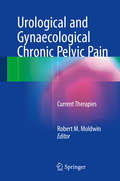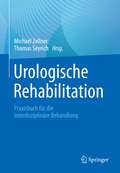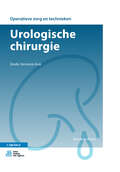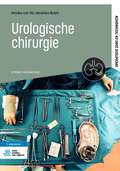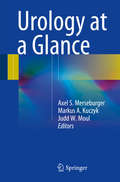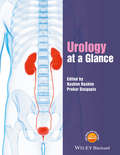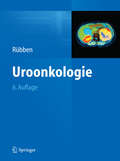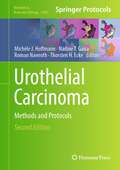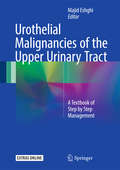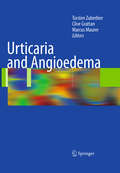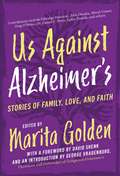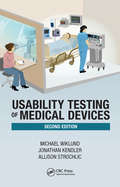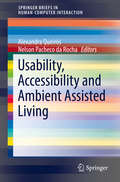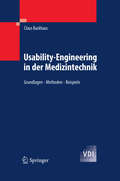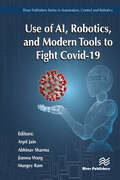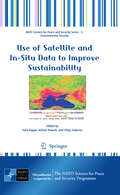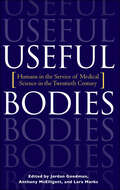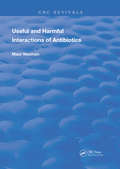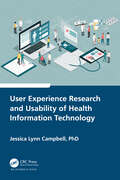- Table View
- List View
Urological and Gynaecological Chronic Pelvic Pain
by Robert M. MoldwinThis text is designed for those clinicians who feel comfortable diagnosing these illnesses and wish to enhance their knowledge base and skill set regarding treatment options. Referrals for pelvic pain are common in urological and gynaecological practice; and may lead to varied diagnoses such as interstitial cystitis/bladder pain syndrome, chronic prostatitis/chronic pelvic pain syndrome, pelvic floor dysfunction, chronic orchialgia, and vulvodynia. To make matters more complex, each of these conditions is frequently associated by co-morbidities. The text is unique in being organized by the multiple and multifaceted therapies that are available, rather than by specific disorders. The text is richly illustrated with multiple diagrams, figures, and tables, making it the "go to" and "how to" reference for patient treatment.
Urologie
by J.L.H.R. Bosch C. H. BangmaKlachten van de urinewegen en de voortplantingsorganen komen voor in elk levensstadium. Urologische aspecten van de menselijke fysiologie zijn van belang in verscheidene kritische processen tijdens de puberteit, de bevruchting, de zwangerschap en het senium, waarin men ernaar streeft gezond oud te worden. De ontwikkelingen in het vak urologie gaan snel. Daarom is actuele kennis over de werking en de afwijkingen van de tractus urogenitalis essentieel voor elke arts. In deze editie van Leerboek urologie zijn de nieuwste ontwikkelingen in de diagnostiek en therapie opgenomen. De meest voorkomende urologische klachten vormen de basis, net als in vorige drukken van dit leerboek. Hierbij is steeds de relatie met de anatomie en de (patho)fysiologie aangegeven. Ook de recente technologische ontwikkelingen komen aan de orde. Moleculaire achtergronden gaan immers een belangrijke plaats innemen in de diagnostiek van morgen. In compacte tekst met overzichtelijke schema's geeft dit handzame boek een heldere weergave van de stand van het wetenschappelijke onderzoek. Aanschaf van het Leerboek urologie biedt de lezer toegang tot de website extras. bsl. nl/urologie met extra materiaal, zoals instructiefilms over het urologisch onderzoek en katheterisatie en een interactieve leermodule over het urodynamisch onderzoek. Ook bevat de website de volledige inhoud van dit boek, waardoor het overal online te raadplegen en snel te doorzoeken is. Leerboek urologie is onmisbaar voor studenten geneeskunde en basisartsen en vormt daarnaast een handig naslagwerk voor specialisten en huisartsen.
Urologie in Österreich: Von Wien in die Welt
by Shahrokh F. Shariat Thorsten Halling Friedrich H. MollÖsterreichische Urologie und internationale Netzwerke vom 19. bis zum 21. Jahrhundert Ausgehend von der akademischen Etablierung einer Spezialdisziplin, die sich mit der modernen Krankenhausmedizin im 19. Jahrhundert etablierte, möchte die Buchpublikation erstmals zentrale Entwicklungslinien der österreichischen Urologie und ihre besonderen internationale Vernetzung nachzeichnen. Aufbauend auf den Arbeiten Neuburgers und Leskys wird der Versuch unternommen, neue wissenschaftliche Ergebnisse einer breiten Leserschaft, die alle an der Urologie und Medizingeschichte interessierte einschließt, näher zu bringen. Im Mittelpunkt stehen dabei neben prägenden Akteuren, zentrale Institutionen, die bisher noch nicht im Forschungsfokus lagen, Fachgesellschaften und konstituierende Themen. Konzeptionell und methodisch folgen die Einzelbeträge aktuellen Fragestellungen der Wissenschaftsgeschichte, wie z.B. Professionalisierung, Netzwerkanalyse, Anerkennungskulturen in den Wissenschaften, Exilforschung, Sexualforschung, Wissenskulturen und dem fachkulturelles Gedächtnis. Hierbei wird auch ein Schwerpunkt für die Zeit zwischen 1938-1945 und die besondere Rolle Wiens und Österreichs im Wissensaustausch mit Osteuropa gesetzt.
Urologische Rehabilitation: Praxisbuch für die interdisziplinäre Behandlung
by Michael Zellner Thomas SeyrichObwohl sich zahlreiche Fachgruppen als auch die Deutsche Rentenversicherung und die Krankenkassen an der Rehabilitation von Patienten mit urologischen und uro-onkologischen Erkrankungen beteiligen, existiert für diese Patienten kein standardisiertes Rehabilitationsprogramm. Zurzeit ist es den Rehakliniken noch weitgehend selbst überlassen, welche Beratungsangebote und Leistungen sie zur Behandlung von charakteristischen postinterventionellen Beschwerden und sozialen Situationen unabhängig von vorgehaltener fachspezifischer personeller und apparativer Infrastruktur und Kompetenz anbieten.Dieses Buch verbindet Praxis- und Fachwissen aus der Rehabilitation von urologisch Erkrankten und stellt es interessierten Kollegen zur Verfügung.Dazu zählt sowohl die Rehabilitation von Störungen der Blasenfunktion als auch von Störungen der Sexualfunktion. Weiterhin werden die Maßnahmen aufgrund der spezifischen Veränderungen nach einer Zystektomie mit den verschiedenen Formen der Harnableitung besprochen. Auch Komplikationen und Folgeschäden nach invasiver Intervention, z.B. einer Operation wie z.B. Lymphödeme im Bein- und unteren Rumpfbereich sollten mit behandelt werden. Für die uro-onkologische Rehabilitation werden sowohl bewegungstherapeutische Maßnahmen als auch psychooonkologische Angebote erläutert. Aber auch flankierende Themen wie Ernährung und eine gesunde Lebensweise sind wichtige Bausteine für eine interdisziplinäre Rehabilitation dieser Patientengruppe. Ein kompaktes Praxisbuch für Ärzte aller Fachrichtungen, die Patienten mit urologischen Erkrankungen in der Rehabilitation bestmöglich versorgen möchten.
Urologische chirurgie (Operatieve zorg en technieken)
by Hendries BoeleDit leerboek geeft aankomende operatieassistenten een helder beeld van operatietechnieken binnen de urologische chirurgie. Ook geeft het achtergrondinformatie bij verschillende ziektebeelden. Daardoor is het ook zeer geschikt als naslagwerk voor andere beroepsgroepen in de gezondheidszorg. Urologische chirurgie is onderdeel van de reeks Operatieve Zorg en Technieken. Die bestaat uit het basisboek en uit een aantal vervolgdelen, waarin de verschillende subspecialismen van de chirurgie worden behandeld. Ieder hoofdstuk begint met een inleiding, gevolgd door een uitwerking van de pre-, per- en postoperatieve fase van de operatie. De opstelling van het operatieteam wordt per operatiebeschrijving verduidelijkt door een afbeelding. Achter in het boek staat altijd een selectie van veelvoorkomend specifiek instrumentarium. De reeks ‘Operatieve Zorg en Technieken’ benadert de beroepsuitoefening van de operatieassistent zo dicht mogelijk. De talrijke afbeeldingen onderbouwen deze benadering. Deze editie van Urologische chirurgie is aangepast aan de meest recente ontwikkelingen in het specialisme. Door de enigszins gewijzigde opzet is deze uitgave overzichtelijker geworden. Ook is er een aantal nieuwe technieken opgenomen, zoals de robotgeassisteerde radicale cystectomie (RARC), de endoscopische transvesicale adenomectomie van de prostaat (ETAP) en de Urolift-procedure.
Urologische chirurgie (Operatieve zorg en technieken)
by Hendries Boele Maaike van TolDit leerboek biedt inzicht in de theoretische en praktische aspecten van urologische operaties. Daarnaast wordt er in dit boek aandacht besteed aan de anatomie van de verschillende organen die behandeld worden binnen het urologische vakgebied en wordt er stilgestaan bij verschillende ziektebeelden.Het boek begint met een uitgebreid algemeen deel waarin een aantal algemene richtlijnen en verschillende specifieke benodigdheden en apparatuur worden besproken. De daaropvolgende delen behandelen de diverse operaties aan de nier, ureter, blaas, prostaat, urethra en de uitwendige geslachtsorganen van de man. Ieder deel begint met een beschrijving van de anatomie en de pathologie die horen bij het orgaan dat centraal staat in dat deel. De volgorde van de ingrepen die aan bod komen loopt van laag complex naar hoog complex. Voor een overzichtelijke beschrijving van de operatietechnieken worden deze, net als de andere boeken uit de reeks Operatieve zorg en technieken, opgedeeld in een preoperatieve, een peroperatieve en een postoperatieve fase.In deze editie van Urologische chirurgie is meer aandacht gekomen voor de oncologischeziektebeelden binnen het urologische vakgebied en de behandeling daarvan. Daarnaast wordt er stilgestaan bij incontinentie bij mannelijke patiënten en ook de behandeling van impotentie komt uitgebreid aan bod. In deze uitgave worden tevens een aantal ingrepen beschreven waarbij het gebruik van een operatierobot centraal staat, aangezien deze techniek inmiddels niet meer weg te denken is binnen de urologie.De reeks ‘Operatieve Zorg en Technieken’ is bestemd voor de opleiding tot operatieassistent.Naast het basisboek bestaat de reeks uit een aantal vervolgdelen, waarin de verschillende chirurgische specialismen worden behandeld. Deze reeks benadert de beroepsuitoefening van de operatieassistent zo dicht mogelijk, waarbij de gebruikte illustraties en afbeeldingen deze benadering ondersteunen.
Urology at a Glance
by Axel S. Merseburger Markus A. Kuczyk Judd W. MoulUrology at a Glance is a concise, practical guide to diagnostic and therapeutic decision making. The book is divided into two parts. The first focuses on the pathway from symptom to diagnosis and covers the full range of symptoms commonly encountered by the urologist. Any particular symptom can be located within a matter of seconds and in each case differential diagnosis is explained with the aid of a flow chart. The second part of the book is devoted to the pathway from diagnosis to therapy, with each short chapter devoted to a specific diagnosis. Basic information is provided on the disease in question, along with an outline of state of the art treatment options and possible complications. Again, flow charts are used to help the reader to reach the correct therapeutic decision in different circumstances. Numerous high-definition photographs and illustrations are also included. This book will be a great asset for urologists and practitioners in related disciplines.
Urology at a Glance
by Prokar Dasgupta Hashim HashimFollowing the undergraduate curriculum set by the British Association of Urological Surgeons, Urology at a Glance offers practical advice on diagnosis and management of one of the most rapidly developing medical specialties. Building on basic science, the book provides an overview of clinical approaches to assist the medical student or junior doctor on rotation, as well as looking at practical procedures and specific details of the most commonly encountered urological disorders. Vibrantly illustrated and containing common clinical scenarios, Urology at a Glance provides all the information and latest guidelines needed for a medical student or junior doctor to excel in this field.
Uroonkologie
by Herbert RübbenDas Standardwerk der urologischen Onkologie aktualisiert in 6. Auflage!Die „Uroonkologie" bietet dem Leser vollständige und umfassende Information zu allen Bereichen des Themas:alle Grundlagen für eine erfolgreiche Therapie von Molekularbiologie über Studienplanung bis zu alternativen Therapieansätzen,alle Details zur Diagnostik, Indikationen, Durchführung und Ergebnis der verschiedenen Therapieansätze aller urologischen Tumorerkrankungen.Zusammenfassende Bewertung der Therapien am Ende jedes Kapitels.NEU: Neugliederung des Inhalts zur besseren Orientierung mit neuen und komplett überarbeiteten Kapiteln zu Themen wie:· Inkontinente- und Rektale Harnableitung· Komplikationsmanagement bei Immun- und Chemotherapie· Sexualität und Krebs· PharmaökonomieEine praxisnahe, klare Sprache, viele Tabellen und instruktive Abbildungen erleichtern das Lesen. Zahlreiche Therapie- und Nachsorgeschemata sorgen für eine schnelle Orientierung und ermöglichen die direkte Umsetzung in die tägliche Praxis.Als Autoren wirken die anerkannten deutschsprachigen Experten zum Thema.Rübben: Uroonkologie - Das Buch, an dem kein onkologisch tätiger Urologe vorbeikommt!
Urothelial Carcinoma: Methods and Protocols (Methods in Molecular Biology #2684)
by Michèle J. Hoffmann Nadine T. Gaisa Roman Nawroth Thorsten H. EckeThis fully updated volume explores recently improved avenues to study urothelial carcinomas. Beginning with several novel chapters on molecular characterization and urothelial carcinogenesis, the book continues with sections on cellular and animal models, biomarkers, and approaches for targeted therapy. Written for the highly successful Methods in Molecular Biology series, chapters include introductions to their respective topics, lists of the necessary materials and reagents, step-by-step and readily reproducible laboratory protocols, as well as tips on troubleshooting and avoiding known pitfalls. Authoritative and practical, Urothelial Carcinoma: Methods and Protocols, Second Edition serves as a valuable resource to further increase our knowledge on urothelial carcinoma and also to aid research on numerous other cancers.
Urothelial Malignancies of the Upper Urinary Tract: A Textbook of Step by Step Management
by Majid EshghiThis book addresses all aspects of upper urinary tract urothelial tumors. It represents the first dedicated text to address solely the symptomatology, diagnostic tools, staging, radical and conservative treatment of these tumors. It describes all new diagnostic tools ranging from radiologic to endoscopic and biopsy techniques, antegrade and retrograde methods of conservative endoscopic resection of tumors. Treatment is described in several chapters including open segmental resection, radical total nephroureterectomy, laparoscopic and robotic assisted procedures. Minimally invasive endoscopic approaches are detailed including ureterscopic retrograde and percutaneous antegrade techniques for larger lesions. Intracavitary chemotherapy and immunotherapy and palliative treatments is also covered. The text is richly illustrated and contains links to video clips for visual impact. Chapters also reflect the current technology and new trends on the horizon.
Urticaria and Angioedema
by Marcus Maurer Torsten Zuberbier Clive GrattanThis book provides a practical and comprehensive review of all types and aspects of urticaria and angioedema important to the clinician. Its content is completely up-to-date, taking into consideration both current guidelines and all recent literature. This clinical guide highlights current knowledge about pathophysiology, and focuses on the clinically relevant aspects of diagnosis and treatment. It also includes a full range of standard operating procedures, as well as patient information leaflets in a copy-ready format, thus offering invaluable assistance in the daily practical management of urticaria patients. This book provides indispensable assistance to all physicians specializing in dermatology, allergy, internal medicine, pediatrics and general medicine.
Urticaria and Angioedema
by Marcus Maurer Torsten Zuberbier Clive GrattanUrticaria is one of the most common diseases encountered in dermatology. The fleeting nature of wheals often makes a first diagnosis by both patients and physicians seem easy. The disease itself is of a highly complex nature, with a variety of clinical manifestations ranging from pinpoint sized wheals to extensive angioedema. Further complexities include the diversity of possible eliciting and aggravating factors, the many different clinical subtypes and the therapeutic responsiveness.This second, extensively revised edition includes the indications listed in the most recent international guidelines, provides a practical, comprehensive review of all clinical aspects and causes, and addresses the diagnosis and therapy of different types of urticaria. Specific chapters are devoted to classification, aetiopathogenesis, patient reported outcomes, acute urticaria, chronic urticaria and its comorbidities, angioedema without weals, inducible urticarias, special populations including children, treatment with antihistamines and omalizumab, other interventions and looking ahead to new therapies. This new edition is a must read for dermatologists, allergists, pediatricians and practitioners of all disciplines who want their patients to benefit from cutting-edge diagnostics and treatments.
Us Against Alzheimer's: Stories of Family, Love, and Faith
by Marita GoldenThis groundbreaking multicultural anthology shares moving personal stories about the impacts of Alzheimer’s and dementia. An estimated 5.7 million Americans are afflicted by Alzheimer’s disease, including 10 percent of those over sixty-five, and it is the sixth leading cause of death. But its effects are more pervasive: for the nearly 6 million sufferers, there are more than 16 million family caregivers and many more family members. Alzheimer’s wreaks havoc not only on brain cells; it is a disease of the spirit and heart for those who suffer from it but also for their families. This groundbreaking anthology presents forty narratives, both nonfiction and fiction, that together capture the impact and complexity of Alzheimer’s and other dementias on patients as well as their caregivers and family. Deeply personal, recounting the wrenching course of a disease that kills a loved one twice—first they forget who they are, and then the body succumbs—these stories also show how witnessing the disease and caring for someone with it can be powerfully transformative, calling forth amazing strength and grace. The contributors, who have all generously donated their work, include Edwidge Danticat, Julie Otsuka, Elizabeth Nunez, Meryl Comer, Greg O’Brien, Dr. Daniel Potts, Sallie Tisdale, and Nihal Satyadev. Reflecting the diversity and global nature of the dementia crisis, this anthology is published in collaboration with UsAgainstAlzheimer’s.
Usability Testing of Medical Devices
by Michael E. Wiklund P.E. Jonathan Kendler Allison Y. StrochlicUsability Testing of Medical Devices covers the nitty-gritty of usability test planning, conducting, and results reporting. The book also discusses the government regulations and industry standards that motivate many medical device manufacturers to conduct usability tests.Since publication of the first edition, the FDA and other regulatory groups h
Usability, Accessibility and Ambient Assisted Living
by Alexandra Queirós Nelson Pacheco da RochaWorldwide, the population ageing is a reality. The concept of Active Ageing, adopted by the World Health Organization, aims to guarantee quality ageing and appears as a strategy to solve this demographic challenge. The technological solutions might have a key role in the promotion of human functioning and in the mitigation of disabilities, particularly those resulting from the natural ageing process. This perspective is evident in the development of Ambient Assisted Living (AAL) solutions. In this context, it is relevant to know about the recent developments in AAL and discuss future trends and challenges in this area. One of the objectives of this book is to do a systematic literature review on AAL, not only considering the technology used, but also the health condition that is intended to improve. For this purpose, we consider the human functioning, in particular the conceptual model of International Classification of Functioning, Disability and Health (ICF). Considering that the ICF conceptual framework is accepted within the healthcare domain, the use of its concepts and terminologies to promote multidisciplinary approaches for AAL solutions development processes can help to overcome difficulties of communication between users, careers and technological developers. AAL solutions must consider in their development the needs of the person that will use AAL solutions. The development must be user-centred and usability questions cannot be forgotten. In addition, the acceptance of the AAL solutions is closely related to the quality of the systems, so it is necessary to appropriately assess these solutions.
Usability-Engineering in der Medizintechnik
by Claus BackhausErgonomisch gestaltete Medizintechnik führt zu effizienteren Arbeitsabläufen, erhöht die Patientensicherheit und reduziert die Arbeitsbelastung. Das Buch erläutert, wie Medizintechnik an die Bedürfnisse der Nutzer und Anwender angepasst werden kann. Durch das beschriebene Vorgehen ist es möglich, sowohl die Anforderungen der harmonisierten Normen DIN EN 62366 und DIN EN 60601-1-6 umzusetzen als auch neue Lösungsansätze für die Entwicklung innovativer Medizintechnik zu erarbeiten. Die Umsetzung wird anhand ausgewählter Praxisbeispiele erörtert.
Use of AI, Robotics and Modelling tools to fight Covid-19
by Mangey Ram Abhinav Sharma Arpit Jain Jianwu WangThe COVID-19 pandemic has hit the global at a colossal scale. With worldwide reported cases of 5.34 million it has led to severe impact on humanity. Being a highly contagious disease, it has given global health services their most severe challenge. Various countries are fighting to minimize the losses due to the outbreak, however a common trait is enforcing lockdown, which has become the main defence mechanism. Researchers are working around the clock to find a breakthrough in the diagnostics and treatment of the pandemic.AI technology is useful for fast drug development and treatment. In the starting phase of COVID-19 pandemic, the medical fraternity in China diagnosed the virus using computed tomography (CT) and X-ray images due to the limitation of testing kits. Deep learning neural network model have also been used for COVID-19 diagnosis. AI assisted intelligent humanoid robots can be used to reduce the human contact and spread of COVID-19. In Italy robots have been used for measuring blood pressure, oxygen saturation and temperature of patients. Robots have also found applications in disinfecting and sterilizing of public places, COVID-19 testing, food and medicine delivery as well as entertaining patients in hospitals and quarantine centers, thereby reducing the workload of doctors and nurses.Prediction of the spread of virus and providing the guidelines or prevention measures is another AI application in COVID-19. Kaggle and GitHub are the two websites where the real-time data of COVID-19 is aggregated. This includes confirmed cases, active cases, cured cases and deaths in each country. This data set can be used for predicting the active cases across different regions of the world so that appropriate amount of health infrastructure can be made available to these places.
Use of Biocidal Surfaces for Reduction of Healthcare Acquired Infections
by Gadi BorkowThe notion that contaminated environments in hospital settings significantly contribute to the risk of an individual acquiring an infection while hospitalized is continuously gaining recognition by the medical community. There is a clear correlation between the environmental bioburden present in a clinical setting and the risk of patients acquiring an infection. Thus using self-disinfecting surfaces can be a very important adjunct in the fight against nosocomial pathogens. This book reviews the increasing evidence that contaminated non-intrusive soft and hard surfaces located in the clinical surroundings are a source of nosocomial pathogens and focuses on the utility of copper containing materials in reducing bioburden and fighting hospital acquired infections. It also reviews other biocidal surface alternatives and the economics of using biocidal surfaces in a hospital environment. Finally, it discusses the pros and cons of existent disinfection modalities other than biocidal surfaces.
Use of Satellite and In-Situ Data to Improve Sustainability
by Alfred Powell Felix Kogan Oleg FedorovMore than 30-year operational satellite data have already been used for monitoring land, ocean and atmosphere. These applications have contributed to improve sustainable economy, produce healthy environment and enhance human life. The Advanced Research Workshop sponsored by NATO and organized by the USA's National Oceanic and Atmospheric Administration and Ukrainian's Space Agency bring the scientists with the most mature research designed for practical use. The goals were to select those which is used for services today and identify the areas to expand research and services. Scientific and application results of the Workshop presented in this book can be used today in agriculture, forestry, water resources, healthy coastal life and fisheries, climate and land cover change, anthropogenic activities and others. The presented papers provide information on how to use operational satellites and in situ measurements for early detection of large-scale droughts, floods and fires, diagnose crop and pasture annual losses, predict periods with health/unhealthy vegetation based on such climate forcing events as ENSO, monitor air quality and geomagnetic activities, assess land cover trends in responce to global warming etc. The available satellite/ground information and method is currently warn with a lead time sufficient to respond, recover and protect.
Useful Bodies: Humans in the Service of Medical Science in the Twentieth Century
by Jordan Goodman Anthony McElligott Lara MarksThough notoriously associated with Germany, human experimentation in the name of science has been practiced in other countries, as well, both before and after the Nazi era. The use of unwitting or unwilling subjects in experiments designed to test the effects of radiation and disease on the human body emerged at the turn of the twentieth century, when the rise of the modern, coercive state and the professionalization of medical science converged. Useful Bodies explores the intersection of government power and medical knowledge in revealing studies of human experimentation—germ warfare and jaundice tests in Great Britain; radiation, malaria, and hepatitis experiments in the U.S.; and nuclear fallout trials in Australia. These examples of medical abuse illustrate the extent to which living human bodies have been "useful" to democratic states and emphasize the need for intense scrutiny and regulation to prevent future violations.Contributors: Brian Balmer, University College London; Miriam Boleyn-Fitzgerald, University of Wisconsin; Rodney A. Hayward, University of Michigan; Joel D. Howell, University of Michigan; Margaret Humphreys, Duke University; David S. Jones, Massachusetts General Hospital; Robert L. Martensen, Tulane University School of Medicine; Glenn Mitchell, University of Wollongong; Jenny Stanton, London School of Hygiene and Tropical Medicine; Gilbert Whittemore, independent scholar/attorney, Boston
Useful Bodies: Humans in the Service of Medical Science in the Twentieth Century
by Jordan Goodman Anthony McElligott Lara MarksA collection of essays that offers “a significant contribution to our understanding of the role of the state in human subjects research” (Journal of the History of Biology).Though notoriously associated with Germany, human experimentation in the name of science has been practiced in other countries, as well, both before and after the Nazi era. The use of unwitting or unwilling subjects in experiments designed to test the effects of radiation and disease on the human body emerged at the turn of the twentieth century, when the rise of the modern, coercive state and the professionalization of medical science converged. Useful Bodies explores the intersection of government power and medical knowledge in revealing studies of human experimentation—germ warfare and jaundice tests in Great Britain; radiation, malaria, and hepatitis experiments in the U.S.; and nuclear fallout trials in Australia. These examples of medical abuse illustrate the extent to which living human bodies have been “useful” to democratic states and emphasize the need for intense scrutiny and regulation to prevent future violations.Contributors: Brian Balmer, University College London; Miriam Boleyn-Fitzgerald, University of Wisconsin; Rodney A. Hayward, University of Michigan; Joel D. Howell, University of Michigan; Margaret Humphreys, Duke University; David S. Jones, Massachusetts General Hospital; Robert L. Martensen, Tulane University School of Medicine; Glenn Mitchell, University of Wollongong; Jenny Stanton, London School of Hygiene and Tropical Medicine; Gilbert Whittemore, independent scholar/attorney, Boston“Each chapter is a startling case study that examines the nature and degree of the state’s involvement in human experimentation.” —Issues in Law and Medicine“Well written and meticulously researched.” —Journal of the History of Medicine and Allied Sciences
Useful and Harmful Interactions of Antibiotics (Routledge Revivals)
by Maur NeumanFirst published in 1987: This book is intended as a guide for a very large group of practitioners in the medical, pharmaceutical, and biological fields. It will enable them to prescribe and use antibiotics in an improved way.
User Experience Research and Usability of Health Information Technology
by Jessica Lynn CampbellHealth information technology (HIT) is a critical component of the modern healthcare system. Yet to be effective and safely implemented in healthcare organizations and physicians and patients’ lives, it must be usable and useful. User Experience (UX) research is required throughout the full system design lifecycle of HIT products, which involve a user-centered and human- centered approach. This book discusses UX research frameworks, study designs, methods, data-analysis techniques, and a variety of data collection instruments and tools that can be used to conduct UX research in the healthcare space, all of which involve HIT and digital health. This book is for academics and scholars to be used to design studies for graduate dissertation work, in independent research, or as a textbook for UX/usability courses in health informatics or related health information and communication courses. This book is also useful for UX practitioners because it provides guidance on how to design a user research or usability study and focuses on leveraging a mixed- methods approach, including step-by-step by instructions and best practices for conducting: Field studies Interviews Focus groups Diary studies Surveys Heuristic evaluation Cognitive walkthrough Think aloud A plethora of standardized surveys and retrospective questionnaires (SUS, Post-study System Usability Questionnaire (PSSUQ)) are also included. UX researchers and healthcare professionals will gain an understanding of how to design a rigorous, yet feasible study that generates useful insights to inform the design of usable HIT. Everything from consent forms to how many participants to include in a usability study has been covered in this book. The author encourages user-centered design (UCD), mixed-methods, and collaboration amongst interdisciplinary teams. Knowledge from many inter-related disciplines, like psychology, technical communication (TC), and human-computer interaction (HCI), together with experiential knowledge from experts is offered throughout the text.
User Innovation in Healthcare: How Patients and Caregivers React Creatively to Illness (SpringerBriefs in Health Care Management and Economics)
by Francesco SchiavoneThis book explores in depth the phenomenon of user innovation in healthcare. In particular, the book sheds light on patient innovation, whereby patients and/or caregivers proactively develop and diffuse new products and services that provide health and quality of life benefits by addressing gaps in existing market offerings. The aim is to clarify the key characteristics of these innovative processes and to offer practitioners and policymakers tangible bottom-up evidence, solutions, and ideas that will assist in improving health systems, organizations, and practices. A number of important and interesting research questions are addressed, casting light on the types of products and services that tend to be developed by patient innovators, the typical profile of these innovators, the role played by firms, institutions, and health professionals, and the ways in which digital technologies support the dissemination of innovations among patient communities and within the industry. Beyond academic scholars and policymakers, the book will be of high value for students on master’s programs in both medical sciences and business and economics.
